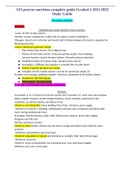ATI proctor nutrition complete guide Graded A 2021/2022
Study Guide
ATI proctor, Nutrition
Chapter 1:
Carbohydrate, protein and fat 3 main nutrients. Carbs: 45-65% of daily calories
function: energy, regulate fat, cardiac and cns system, protein metabolism.
Glycogen: stored carb in the liver and muscle and it release between the meals to regulate the
Blood glucose level.
Carbs 4 calories per gram per energy
*Fiber intake 25gr women, for M 38gr per day
*Protein 10-35% daily calories, 0.8 gr per kg body weight, tissue building, immune function, neutral nitrogen balance. Wound healing is important.
▪Complete protein: all 9 amino acids, animal sources and soy
▪Incomplete: 2 different one together is complete like rice plus beans.
▪Protein 4 calories per gram per energy.
▪Fat lipids: 20-35% of daily calories. Les that 10 sutured fat, ideally 7%
Function: store energy, padding insulation. Hormone, absorption of fat-soluble vitamin
▪Cholesterol: 200-300 mg/day
▪Fat provides 9 calories/energy
If you eat 5 gr of fat how many calories: 45 calories.
Vitamins:
Fat soluble: A, D, E, K they have risk for toxicity, don’t overdose, CF, celiac and crohns disease Water soluble: Vitamin C and B complex thiamine, niacin, pardaxin, panthocacid, folic, cobalamin: no risk for toxicity, you will pee it out.
Vitamin c: iron absorption, tissue building Citrus fruits, tomatoes, green veggie.
Deficiency in vitamin C: bleeding, swelling gums and joint pain, during pain and illness take more, during smoking take more
B complex: CNS functioning, meats, milk, whole grains, legumes, green leafy veggies. Pregnancy get folic acid.
Def B12: pernicious anemia.
Vitamin A: vision health, skeletal and soft tissue: orange and yellow fruits, fatty fish, dairy products.
Deficiency: xeropthalmia and vision issue
Vitamin D: absorption of calcium and phosphorus. Sunlight, Milk, fatty fish and eggs. Deficiency: bone loss
Vitamin E: serve as antioxidants: fat containing food, nuts, dark green veggies. Deficiency very rare: muscle pain. ATI proctor nutrition complete guide Graded A 2021/2022
Study Guide
Vitamin K: blood clotting and bone maintenance, dark green veggie, carrots deficiency: increase bleeding time. Antidote for Warfarin
Electrolytes:
Sodium Na: 136-145 normal level.
function: fluid balance and nerve and muscle function. Food high in Na: salt and processed food.
Hyper: hypervolemia and HTN
Hypo: confusion, muscle cramps, headache, fatigue, NV
Potassium K: 3.5-5 normal level.
Function: ICF, nerve function, muscle and heart contraction
FOOD HIGH IN K: bananas, potatoes, tomatoes, oranges, avocadoes, dark green veggies, dried foods
Hyper: dysrhythmias, muscle weakness, NV, confusion Hypo: dysrhythmias, muscle cramps and constipation
Chloride Cl: 98-106 is normal level
Function: Help with digestion, ICF and ECF. Find in salt Hyper: NV
Hypo: muscle cramps, GI upset
Calcium CA: 9-10.5 is normal level
Function: bone, teeth formation, nerve and muscle function, BP Food: dairy, dark green veggie, fruits
Hyper: constipation, decreased DTR, kidney stones, lethargy Hypo: Positive Chvostek and Trousers’, muscle spasm and tingling
Magnesium Mg: 1.3-2.1
Function: Nerve, muscle function, bone formation, biochemical reactions Foods: nuts, veggies, whole grain, milk
Hyper: NV/ hypotension, muscle weakness, lethargy. Respiratory and cardiac arrest Hypo: increased DTR, dysthymias, seizure, tremors
Ph: Phosphorus 3-4.5 is normal level
Function: bone and teeth formation
Dairy and cheese, dark green veggies, fish and legumes Inverse relationship with calcium, high Calcium low Ph




